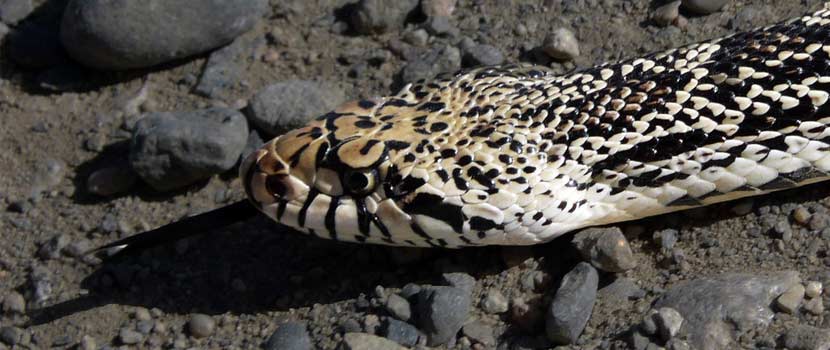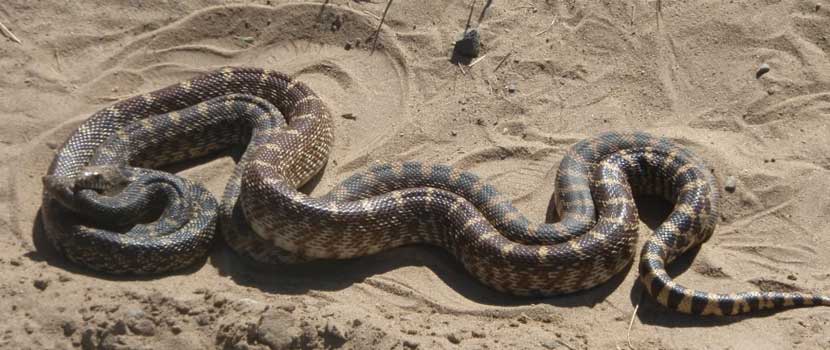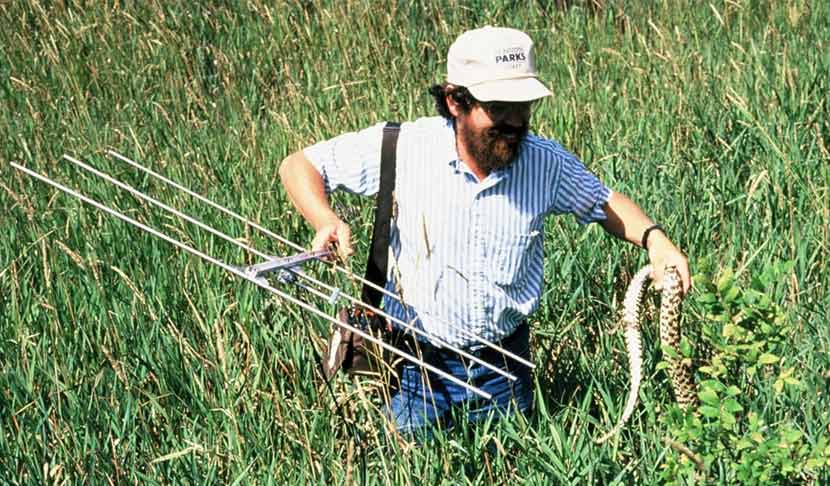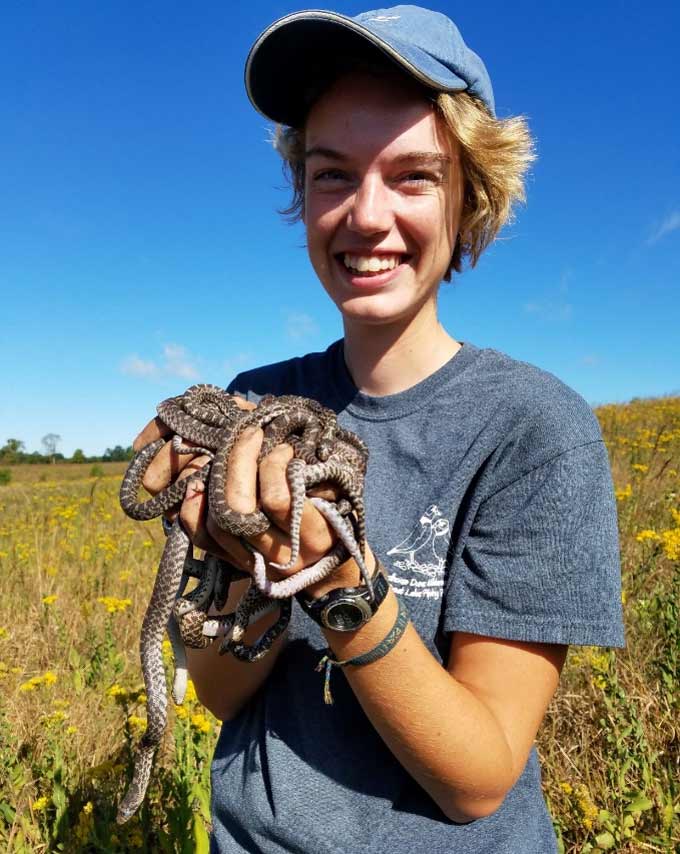How Big Do Bull Snakes Get
In 1991, Three Rivers began an ongoing effort to reintroduce bullsnakes, also known as gopher snakes, into Crow-Hassan Park Reserve. Information technology took time, patience and careful record-keeping, only since so we've seen steady growth in the population.
If you lot read our mail on species reintroduction, you know that we often cull to reintroduce a species that we tin provide adequate habitat for, easily collect from another surface area, and that is likely to thrive in the long-term. Bullsnakes, a state-listed species of special concern that has become scarce in Minnesota, fit the bill.
In this post, learn all nearly bullsnakes, their habits and how to identify them, then observe out more about how we reintroduced them into the prairie at Crow-Hassan and tracked their success.
Range
Bullsnakes range from western Wisconsin and Illinois s to Texas and due west to the Pacific declension. In Minnesota, bullsnakes are found in the southern half of the state. Many records of bullsnakes in Minnesota come from counties adjoining the Mississippi, Minnesota, and St. Croix Rivers.
Identifying Bullsnakes
Bullsnakes are the longest snakes in Minnesota, reaching a length of more 6 anxiety. They are powerful, stout-bodied constrictors.
Bullsnakes have a yellow head that has many black or near-black markings, including a assuming stripe from the eye to the corner of the mouth. They have prominent vertical lines on their upper lip, and their heads are pointed.

Their bodies are straw-yellow or light brown, with night-brown or ruby-brown blotches down their backs. The blotched pattern is less obvious near the head but becomes bolder near the tail, which has black or reddish-dark-brown bands.
The mentum and belly are pale yellow, and the belly has several square or rectangular dark spots. Many individuals bear witness a pronounced color change from head to tail.
The pattern of juvenile bullsnakes is similar to adults, simply their overall colour is lighter.
Habitat and Hibernation
Bullsnakes are snakes of open up country. They prefers native prairies, former fields, pastures, oak savannas, and barefaced prairies that are located on steep hillsides. Bullsnakes thrive in sandy-soil habitats where burrowing rodents are mutual.
Bullsnakes emerge from hibernation in late April or May. In the Twin Cities area they hibernate in gopher tunnels and other burrows that go below the frost line.
In the summer, bullsnakes use big areas of land. They have an average home range of xviii acres just tin can utilise over 500 acres during their active season: belatedly spring and summer. Some snakes travel over 1.five miles during the summer.
They are by and large diurnal – meaning they are agile during the day. Bullsnakes can climb, only they spend well-nigh of their fourth dimension foraging and resting in rodent burrows. They are fond of basking on warm sand, rock, or pavement. Their active season generally ends in tardily September or early Oct.
What Do They Swallow?
Bullsnakes are constrictors that eat gophers and a diverseness of other small mammals, including mice, voles, ground squirrels, and tree squirrels. Other prey include frogs, ground-nesting birds, and bird eggs. Bullsnakes are at risk when trying to subdue a large rodent, and may be badly bitten or, in rare instances, killed in the procedure.
Bullsnakes are extremely beneficial predators, eliminating numerous pocket gophers and ground squirrels. Landowners battling rodent populations in croplands or grasslands benefit from having snakes nearby. Killing fifty-fifty one snake will do good the rodents.
Mating and Hatchlings
Bullsnakes mate in May. In June or early July, females lay a single clutch of iii to 24 eggs (average of 12) in a self-dug nest. The nest may be out in the open or under a large rock or log in loose, sandy soil. Communal nests have been reported, simply they are not common.
The whitish eggs have rough, leathery shells and average 1½ by 2 inches. Eggs grow in width and mass during the evolution period.
Eggs accept nearly 60 days to hatch. Hatchlings are typically 10 to 17 inches long. They shed their skin for the outset fourth dimension at vii to 10 days of age.

What Happens if You See A Bullsnake In The Wild?
When encountered in the wild, bullsnakes make every attempt to escape, often diving for the first available burrow. If left without a retreat, they can put on an impressive display of fierceness.
An agitated bullsnake coils upward, apace vibrates its tail, hisses loudly, and strikes repeatedly. In dry leaves, the vibrating tail makes a sound similar to a rattlesnake. No other snake in Minnesota can hiss as loud equally a bullsnake. Although nonvenomous, a large adult can deliver a painful bite.
If you come up across a bullsnake, the best thing to do is go on your altitude and leave it exist. Bullsnakes won't chase or follow you.
Do Bullsnakes Have Predators?
Adult bullsnakes don't take many predators, simply a large hawk or predatory brute may occasionally have one. Young snakes fall casualty to birds, mammals, and other snakes.
Unfortunately, road traffic and habitat destruction are far greater threats to bullsnakes. Many snakes are as well needlessly destroyed past humans due to fear and misinformation.
The Minnesota Section of Natural Resources classifies bullsnakes as a species of Special Concern and lists information technology as a Species of Greatest Conservation Need.
Reintroducing Bullsnakes at Crow-Hassan Park Reserve
In 1991, Three Rivers conducted an initial search for bullsnakes in Crow-Hassan Park Reserve. Six park staff spent over 100 hours in the park that June and did not see one bullsnake.
Knowing that Crow-Hassan had an ideal habitat for bullsnakes, we decided to reintroduce them into the park.
1991-95 Reintroductions
Ix bullsnakes were collected from Sherburne National Wildlife Refuge 25 miles northward of Crow-Hassan. They were released into Crow-Hassan in June 1991. Prior to release, 6 of the snakes were implanted with radio transmitters.
The radioed snakes were first relocated the day after their release. That year, we recorded 162 relocations. There were only two sightings of bullsnakes outside of relocation attempts. The furthest a snake moved abroad from the release site was a straight line of over i mile. The not-radioed snakes were never recaptured.
Betwixt 1993 and 1995, an boosted 36 snakes (29 captive-born hatchlings and 7 adults) were added to Crow-Hassan.

1995 to 2013 Sightings
From 1995-2013, average almanac bullsnake sightings gradually increased:
- 1995-2000: less than ane sighting per year
- 2000-2009: three sightings per year
- 2010-2013: half dozen sightings per year
While sightings have been limited overall, they show the presence and growth of the bullsnake population.
How Are Bullsnakes Doing Now?
Starting in the summer of 2014, Natural Resources staff has been catching bullsnakes in Crow-Hassan as they came across them while conducting other work, like bird surveys, weed control and seed collecting. Nosotros mark the snakes with the same tags used past veterinarians to "chip" dogs and cats.
A total of 128 adult bullsnakes – 75 females and 52 males – have been caught to date. Only 27 of the marked snakes have been re-caught. Several hundred hatchlings take been caught, merely they were not marked or processed.

Nosotros also found four snakes that had been killed on the roads bordering the park in the concluding 2 years, indicating that they have expanded beyond the park.
In belatedly June 2017, we captured 32 pregnant female person bullsnakes over the span of four days in a ½-acre expanse of the prairie. Communal nesting by bullsnakes has been reported in other parts of their range with the number of females in one nest ranging from three to xv.
Restoring and growing the population of a reintroduced species can have time, endeavour and patience. The pay off, still, is worth information technology. Afterward more than 20 years, bullsnakes are now regularly observed at Crow-Hassan. No other areas accept matched the density found there.
Learn something in this post? Curl downward to subscribe to exist the first to know about new web log posts!
Annal image credit: "Bullsnake - Pituophis catenifer sayi" by smalleraperture is licensed under CC By-NC-SA ii.0.
How Big Do Bull Snakes Get,
Source: https://www.threeriversparks.org/blog/all-about-bullsnakes-and-how-they-found-home-three-rivers
Posted by: perrydaunded.blogspot.com


0 Response to "How Big Do Bull Snakes Get"
Post a Comment